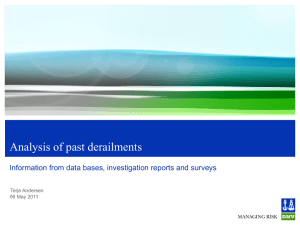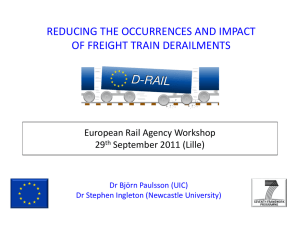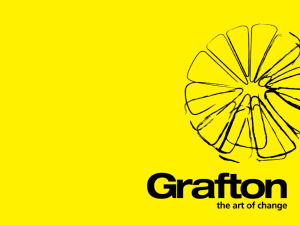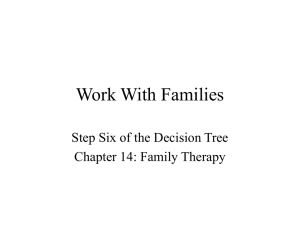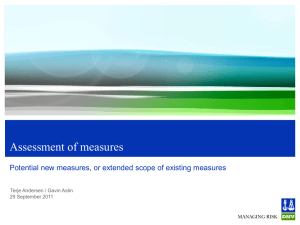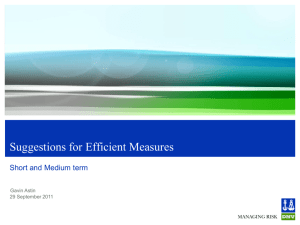Analysis of past derailments - part 1
advertisement
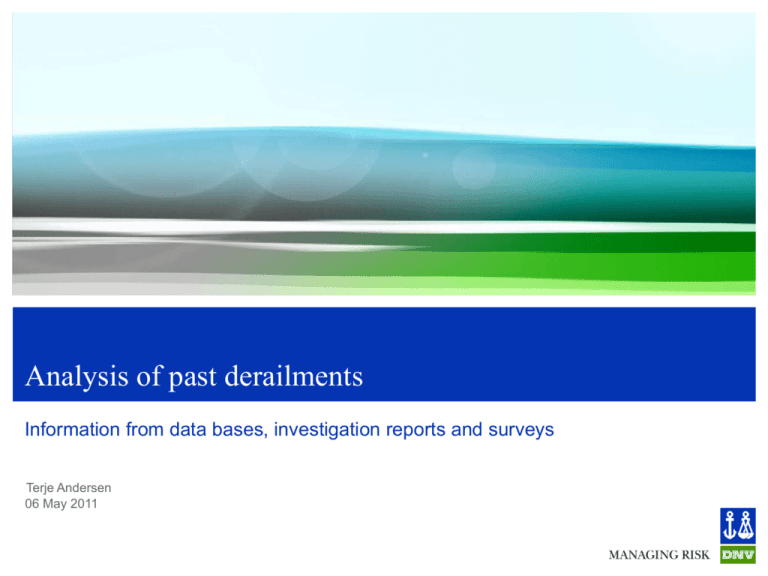
Analysis of past derailments Information from data bases, investigation reports and surveys Terje Andersen 06 May 2011 Purpose of Accident Analysis Qualitative Analysis: - To provide information on observed derailment causes. - To identify those causes that are “single point failures” and that in most cases can be considered direct derailment causes (axle failure, wheel failure etc). - To identify those causes that are “contributory” and can be considered to make a derailment more likely (by eroding the safety margin, e.g. operational issues, wagon skew loading etc). - To identify the range of possible consequences following a derailment. - And therefore to provide the structure for a risk model. Quantitative Analysis: - To provide statistical analysis of the relative frequency of individual / combinations of failures leading to a derailment. - To provide statistical analysis of the relative likelihood (probability) of consequences following a derailment. - And therefore to provide the data for a risk model. Analysis of past derailments 06 May 2011 2 Depth and Breadth of Accident Analysis Accident Investigation reports from National Investigation Bodies (NIB): - The percentage of derailments investigated by the National Investigation Bodies varies significantly from country to country. - Some countries investigate a very high number of railway accidents and go far beyond what is mandatory. Annual reports of National Investigation bodies: - For countries reporting only mandatory accidents, the annual reports of the NIBs can give some information on “non-investigated” accidents. ERADIS database entries: - Supported by the accident investigation report where required to provide additional information. Previous Agency survey - Significant amounts of information has also received from the Agency for the 2008 study of the Derailment Detection Device. Other information sources. In total we have about 700 freight train derailment accidents (although some of these are marshalling / freight yard derailments) in our database, covering 23 countries. Analysis of past derailments 06 May 2011 3 Accident Analysis Summary Accident Causes Breakdown 1% 25% 36% 37% Infrastructure Rolling stock Operational failure Analysis of past derailments 06 May 2011 4 Others (environment etc) Accident Analysis Findings - Infrastructure Track geometry defects account ~ 70% of infrastructure related derailments, and ~ 30% of all derailments 80% 70% 60% 50% 40% - Excessive track twist 27% - Excessive track gauge 19% 30% Main controls are inspection, maintenance, adherence to standards etc. 10% 20% 0% Substructure (subsidence, bridge failure etc) Superstructure (rail ruptures, fastening, switch etc) Track geometry (twist, width, height, cyclic tops, buckles etc) Other Occur more often in station at turnouts or signals However, in many cases the defect was known about. Derailments due to sun curve (heat buckle) are more common in Nordic countries. Analysis of past derailments 06 May 2011 5 Accident Analysis Findings – Rolling Stock Axle ruptures and wheel failures account ~ 57% of rolling stock related derailments, and ~ 20% of all derailments. - Bearing failure -> hot axle box -> axle journal rupture most frequent RS caused derailment scenario Main wagon controls are inspection, maintenance, adherence to standards. 45% 40% 35% 30% 25% 20% 15% 10% 5% 0% Failure of axles (ruptures) Failure of wheels (composite or monoblock) Bogie Suspension and Structure (spring, wagon frame etc) Others and Unknown - Infrastructure detection devices However a number of trains derailed due to a HAB had recently passed a HABD. HAB failures are less common in some countries than others. Analysis of past derailments 06 May 2011 6 Accident Analysis Findings – Operations Incorrect / improper loading account ~ 25% of derailments caused by operational failures, and ~ 10% of all derailments. Main controls are: - operational rules inspection functional tests training & competent staff 30% 25% 20% 15% 10% 5% 0% Train formation and testing (train composition, brake test not performed etc) Train loading (overload, skew loading etc) Mishandling of train (overspeed etc) Turnouts (point movement, incorrect setting etc) Others (objects under train, etc) Main failings are human errors / acts of omission / acts of commission. Skew loading often works in combination with track geometry defects leading to derailments. Analysis of past derailments 06 May 2011 7 Combination of causes often necessary to cause derailment Very often the derailment is caused by a combination of several contributory causes e.g.: - Combination of faults of infrastructure and rolling stock - Combination of a Rolling stock or Infrastructure fault and unfortunate train handling/operation Typical examples are: - Low train speed and sudden train braking action combined with: - Track twist, narrow curve with high cant - Track twist, wagon with very long wheel base - Track twist and twisted or skew loaded wagons - Track geometry fault and strong compression forces in train due to unfortunate train composition or less than optimal train handling by the driver Existing measures are often directed towards control of these common causes of freight train derailment, with varying degrees of success. Analysis of past derailments 06 May 2011 8 Some causes in detail – Rolling Stock The event sequence bearing failure > hot axle box > sheared axle journal is the most common derailment cause accounting for about 40% of rolling stock derailments. There appear to be geographic differences between countries. Most, but not all, countries have hot axle box detectors trackside to provide warning: - But present use of HAB-detectors is far from 100 % effective Analysis of past derailments 06 May 2011 9 Excessive track twist most important infrastructure failure cause Derailments occur under presumably safe conditions Upper figure shows track twist limitations for curves R > 420 m - UK has more lenient requirements - > higher proportion of track twist derailments - Derailment has occurred within allowable limit - Neulengbach (AT) Lower figure shows track twist limitations for curves R < 420 m - Derailment has occurred within allowable limit - Fetsund (No) & Rosenbach (AT) Analysis of past derailments 06 May 2011 10
